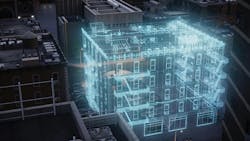AI in Building Design and Automation: Hype vs. Reality
By NATHAN KEGEL, Vice President, IES Ltd.
"Artificial intelligence" (AI) has reached peak buzzword status in the building sector. Promises range from faster design iterations and energy optimization to fully autonomous building operations. But how much of the hype is grounded in reality?
So what do mechanical engineers and building automation professionals need to know before investing their trust—and their reputations—into AI-driven systems?
Not All “AI” Is the Same
First, it’s worth clarifying that not all tools labeled “AI” are created equal. What’s often marketed as artificial intelligence may, in fact, be advanced analytics, rule-based automation, or machine learning (ML). These distinctions matter, particularly in safety-critical environments like HVAC and building systems, where predictability, transparency, and traceability are essential.
In most current applications, what we’re seeing in the built environment is machine learning: algorithms trained on large datasets to identify patterns or predict outcomes. For example, an ML model might learn to predict a building’s heating load based on historical occupancy and weather data.
Current AI systems are typically designed for specific purposes (image recognition, language translation, etc.) and generally lack the understanding and adaptability that humans possess. In other words, complex reasoning is not yet something that current AI systems can undertake.
True artificial intelligence—systems that adapt autonomously and make complex decisions without human oversight—is still a theoretical concept. Some prognosticators believe this ‘artificial general intelligence’ (AGI) will be possible within five to 10 years, while others believe it will be more like one to four years. But it’s not here yet.
Where AI Is Making a Difference Today
That said, there are several areas where AI and ML are beginning to add measurable value in engineering workflows:
1. Predictive Controls and Optimization
In building automation, AI is increasingly used to refine control strategies. Predictive models can optimize setpoints based on anticipated conditions rather than reacting in real time. For example, a chilled water system might preemptively adjust in response to forecasted outdoor temperatures and occupancy schedules, improving efficiency and comfort.
Some smart building platforms now incorporate reinforcement learning—a type of AI that learns from trial and error—to improve their performance over time. When implemented carefully and monitored closely, these systems can reduce energy consumption and operational costs.
2. Fault Detection and Diagnostics (FDD)
AI-powered fault detection tools can analyze building system data in real time to detect anomalies, alert operators, and even suggest corrective actions. These tools reduce diagnostic time, improve maintenance planning, and help prevent small issues from turning into costly failures.
However, engineers must remain in the loop. Automated diagnostics are only as good as the data they’re fed, and as the assumptions behind the models.
3. Design Assistance and Load Prediction
Some software platforms are now using ML to support early-stage design. For instance, algorithms can predict heating and cooling loads based on historical project data or suggest equipment selections based on comparable building types. While this isn’t a replacement for detailed simulation, it can streamline initial iterations and support concept development.
There is also potential for AI to improve building performance modeling by calibrating simulation models against real-world data. This could help bridge the persistent gap between predicted and actual performance, a challenge that continues to frustrate both engineers and building owners.
However, finding “good” data with which to train AI models for load calculations and energy simulation in the design of a new building is a real challenge.
Limitations and Risks to Watch
Despite these promising use cases, there are significant limitations that engineers must be aware of before relying on AI:
1. Data Quality and Quantity
AI systems require vast amounts of clean, relevant data to function well. In many buildings, that data simply doesn’t exist, or if it does, is riddled with gaps, inconsistencies, and sensor errors. Poor data leads to unreliable outcomes, and engineers bear the consequences when systems don’t perform as expected.
2. Lack of Transparency
Many AI models operate as “black boxes,” meaning their internal logic is opaque. For engineers accustomed to physics-based modeling and deterministic outcomes, this lack of explainability is a problem, especially when regulatory compliance or liability is on the line.
3. Context Blindness
AI doesn’t understand context the way humans do. It may detect a correlation between outdoor temperature and energy use, but it doesn’t know about a broken damper, a recent tenant change, or a mechanical override. Human oversight remains essential, particularly in systems that control indoor environmental quality or safety functions.
4. Overpromising and Under-Delivering
In some cases, marketing claims outpace technical reality. Engineers should be cautious of solutions that promise “autonomous optimization” without offering transparency, audit trails, or clear ROI. Building owners are increasingly asking for accountability—not just automation.
5. Environmental Impacts
While AI holds a lot of potential and has already contributed significantly to improvements in medicine and biology, AI systems require a lot of resources to be manufactured and operated. The environmental impacts of the continued development and build-out of AI infrastructure are not yet fully understood, but include:
- Energy: AI is extremely power-hungry. The estimate reported by a Google AI search of how much power was consumed to train GPT-4o was 65,000 Mwh. This is enough electricity to power over 1.2 million U.S. homes for one hour or roughly 1,400 homes for an entire year. AI’s current power consumption is roughly the same as that of Japan;
- Water: According to one study, AI is on track to consume between 4.2 and 6.6 billion cubic meters of water per year by 2027. This would mean AI would consume 4-6 times the amount of water as the entire country of Denmark;
- Materials: According to the United Nations Environment Programme (UNEP), for every 800 kg of raw materials, only 2 kg ends up as useful materials. This puts the efficiency of manufacturing AI chips at 0.25%. In addition, many of the materials used are known to contain hazardous materials like lead and mercury.
Given the enormous environmental impact, more transparency is needed so design firms can make informed decisions about which tasks are worth the additional infrastructure which is required to “sustain” AI.
Practical Advice for Engineers
For mechanical engineers and system designers evaluating AI-based tools, here are a few considerations:
- Start with a clear use case. Identify a specific, high-value problem to solve, such as peak load reduction or fault detection, and assess whether AI tools can address it better than conventional methods;
- Insist on transparency. If a model influences a design decision or control strategy, you should understand how it works and be able to verify its recommendations;
- Test before scaling. Pilot AI solutions in a limited, controlled environment to validate performance and build confidence;
- Keep the human in the loop. AI should support engineering judgment, not replace it.
The Path Forward
AI has the potential to reshape how we design and operate buildings, but we are still in the early stages. Right now, the most successful applications are narrow, well-defined, and paired with strong human oversight.
Rather than expecting AI to automate entire design workflows or eliminate human operators, we should see it as a tool that can augment decision-making, improve accuracy, and free up time for higher-value work.
The future of building design and automation will likely involve a hybrid model: physics-based simulation and controls where transparency and precision are essential, and AI where data-rich, adaptive decision-making can offer an edge.
In the meantime, engineers should remain curious, but skeptical. Ask questions. Demand clarity. And above all, remember that while the tools are evolving fast, the principles of good engineering—rigor, accountability, and service to the end user—remain the same.
###
About the Author
Nathan Kegel is Vice President, North America, for IES, a global climate tech company delivering innovative software solutions and consultancy services to decarbonize the built environment. In this role, he is focused on enabling the AEC sector to reduce the carbon emissions of the buildings they design, build and operate. Having previously worked for IES between 2011-17, Kegel rejoined as a Vice President in 2022. He gained additional professional experience as a Building Performance Analyst at integrated design firms, DLR Group & SmithGroup. A resident of Minneapolis, MN, he holds both a BA and Certificate of Construction Management from the University of Minnesota, as well as an MBA from the University of Phoenix.


